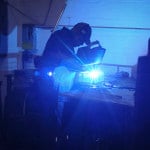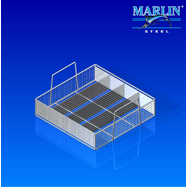 Some parts washing and finishing cycles are simple one or two-step affairs that can be completed quickly and easily. This is not always the case, however.
Some parts washing and finishing cycles are simple one or two-step affairs that can be completed quickly and easily. This is not always the case, however.
For many complicated or sensitive parts, the finishing process can involve many different steps, even when the part is being processed through a single machine. This was the case for a client with a request for a custom parts washing basket design for their parts washing machine.
How complicated was this one process on this single machine? The process involved eight separate phases, including:
-
Loading.
-
Wash with 6kW heat
-
Rinse at 6kW heat
-
Ultrasonic wash with 40kHz @2000W with 6kW heat
-
Ultrasonic immersion rinse with 132kHz @1500W with 6kW heat
-
Ultrasonic cascade rinse with 132kHz @1500W with 6kW heat
-
Drying cycle at 12.5kW heat
-
Unloading.
From the individual steps involved in this wash process, any custom baskets designed for this would have to be designed to withstand not only prolonged exposure to the solvents and solutions used in the machine’s multiple wash and rinse cycles, but to the stresses caused by exposure to ultrasonic vibrations and cavitation as well.
Additionally, these baskets would need to be made easy to handle manually, as there was no automated conveyor system in place that could neatly slot a basket into each of the machine’s chambers in between processes.
Ensuring Maximum Efficiency
 For a basket to provide the maximum efficiency, it would have to be able to hold a set of the customer’s parts from the first phase of the process to the end without having to stop and switch to a different set of baskets. Each time an employee has to unload one basket of parts to put them into another basket, production has to grind to a halt as the employee carefully moves delicate parts so as not to damage them.
For a basket to provide the maximum efficiency, it would have to be able to hold a set of the customer’s parts from the first phase of the process to the end without having to stop and switch to a different set of baskets. Each time an employee has to unload one basket of parts to put them into another basket, production has to grind to a halt as the employee carefully moves delicate parts so as not to damage them.
Because of this, any basket design that will be used for parts being put through multiple processes needs to be able to withstand all of them. To accomplish this goal for this multi-phase parts cleaning machine, Marlin’s engineers created a basket with:
-
Wire Mesh. In cleaning processes that involve aqueous solutions, wire mesh is an ideal basket material. The wires can be spaced as closely as needed to keep parts from falling out, and as loosely as needed to allow the solution to penetrate the basket and reach parts easily. The rounded surface of the wires in wire mesh further prevent liquids from settling on the basket, allowing them to drain completely.
-
Thicker Gauge Wires. In addition to using wire mesh, thicker wires were employed to increase the basket’s durability in the face of ultrasonic vibrations and the cavitation process. This allows each basket to be useful for years of use without breaking or becoming too deformed to use in the machine.
-
Handles. Since each basket has to be moved manually from one process to the next, it is imperative that the baskets be designed with ease of handling in mind. However, handholds could not be too large or obtrusive, as the basket still needed to fit in side of the machine. Small handles were added to the basket to allow workers to grab it easily so that the basket could be moved quickly along the table to the next process station.
-
Stainless Steel. Plain steel simply does not have the corrosion resistance to handle continuous exposure to aqueous cleaning solutions for long. To prolong the useful life of the basket, corrosion-resistant metal such as grade 304 stainless steel should be used. Grade 304 stainless steel possesses an incredibly high resistance to corrosive chemicals and the effects of oxidation. Using this material allowed a single basket to survive all of the phases of this parts washing machine without needing to be changed out.
The above design features were integral to ensuring that the parts in the basket could be moved from one process to the next as quickly and efficiently as possible so that the downtime between processes was minimized. This, in turn, allowed the client to maximize efficiency for this parts washing process, saving time and labor while increasing throughput for parts processed using this one machine.
Why optimize for a Single Basket to be used from Start to Finish?
How much can throughput be increased by using one basket for all processes rather than having to use two? The answer depends on the part being processed and the length of the process.
For example, if the above machine has a total process time of 30 minutes start to finish, running one load of parts at each of the six stations (not counting initial loading and final unloading stations), that would be 12 loads of parts per hour once the machine was up to full production. In an 8 hour shift, this would mean that 96 loads of parts could be processed at maximum efficiency.
However, if the parts have to be moved from one type of basket to another halfway through, the time it takes to move over parts has to be added to the process. We’ll say the employee is pretty speedy and experienced, so this extra process only takes 1.5 minutes, bringing the total process time to 31.5 minutes. Because of this added time, there is only time to produce 91 complete loads per shift, a 6% drop in productivity, meaning more labor spent on completing an order.
On top of the lost productivity from adding another step to the process, the moving of delicate items from one container to another increases the risk that a part may become damaged from mishandling, which requires the part to either be reprocessed or scrapped and replaced. This costs you not only more on labor, but on materials in reworking or replacing damaged parts.
Over time, these costs can really add up and eat away at your bottom line. By using a well-designed basket that improves the efficiency of your production work flows, you can save yourself money in the long run.
Learn more about this and other custom basket design issues by contacting Marlin Steel today.


.gif)


